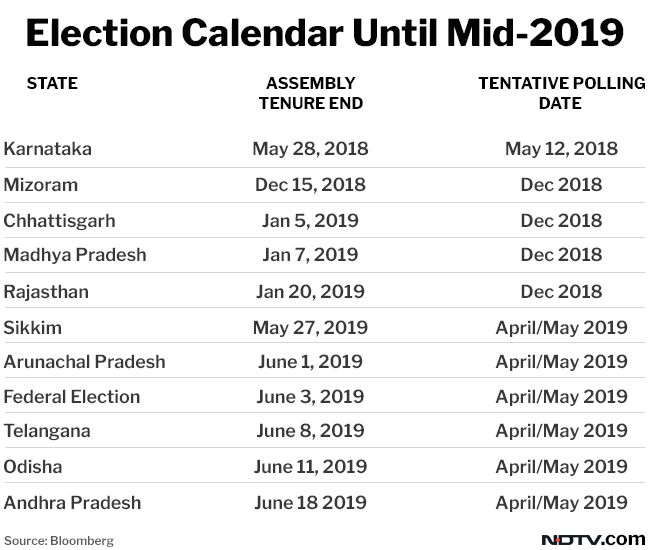
PM Narendra Modi argued simultaneous elections will save time and money (Reuters)
Prime Minister Narendra Modi wants to end the country's relentless election cycle, where about six states go to the polls each year.
The Law Commission, which provides advice to the government, backs the initiative and said simultaneous elections for the lower house of parliament and state assemblies could be held in two phases starting in 2019. Its recommendations come months after PM Modi and President Ram Nath Kovind pitched the idea.
Joint elections would require constitutional amendments as well as ratification by the majority of 29 states, the Commission said in a draft working paper released on Tuesday. Yet given it took more than a decade to build consensus among states for the launch last year of the national sales tax GST, getting state leaders on board for this electoral reform could prove difficult.
PM Modi argued simultaneous elections will save time and money, while allowing political parties to focus on policy and governance. But critics warned the move was a threat to democracy and would curtail the legislature's power to unseat a government.
 "This will destroy the federal structure of the country and will go against the interests of regional parties," because federal elections would overshadow state polls, said Sanjay Kumar, director of the New Delhi-based Centre for the Study of Developing Societies.
"This will destroy the federal structure of the country and will go against the interests of regional parties," because federal elections would overshadow state polls, said Sanjay Kumar, director of the New Delhi-based Centre for the Study of Developing Societies.
Elections were held concurrently for nearly two decades after 1951. The practice was disrupted in the late 1960s with the premature dissolution of some state assemblies.

In its recommendations, the Law Commission said a second phase of simultaneous polls could take place in 2024, after the synchronisation of state election cycles. The government think tank NITI Aayog suggested in January 2017 that extending and curtailing the duration of some state assemblies would allow half the assembly elections take place along with the general election in 2019, followed by the rest in 2021.
But states ruled by regional parties could complicate those plans.
"The way regional parties are reasserting their federal autonomy and political independence, holding simultaneous polls by 2019 looks a bit difficult," said SY Quraishi, former Chief Election Commissioner. "Building political consensus has become tougher," he said.
 According to a study published by the IDFC Institute, there was a 77 per cent chance a voter would support the same party at central and state levels if elections were held simultaneously.
According to a study published by the IDFC Institute, there was a 77 per cent chance a voter would support the same party at central and state levels if elections were held simultaneously.
Managing joint elections would cost about Rs 45 billion, NITI Aayog said, citing the Election Commission of India. India spent about Rs 38.7 billion on the 2014 general election, while each state assembly election costs as much as Rs 3 billion, its report said.

"It's an extremely laudable move by the government," said Ajay Bodke, chief executive at Mumbai-based Prabhudas Lilladher. "Besides saving poll expenditure, it will help the government by shifting focus from continuous electioneering to the delivery of promises made to electorates."
The Law Commission, which provides advice to the government, backs the initiative and said simultaneous elections for the lower house of parliament and state assemblies could be held in two phases starting in 2019. Its recommendations come months after PM Modi and President Ram Nath Kovind pitched the idea.
Joint elections would require constitutional amendments as well as ratification by the majority of 29 states, the Commission said in a draft working paper released on Tuesday. Yet given it took more than a decade to build consensus among states for the launch last year of the national sales tax GST, getting state leaders on board for this electoral reform could prove difficult.
PM Modi argued simultaneous elections will save time and money, while allowing political parties to focus on policy and governance. But critics warned the move was a threat to democracy and would curtail the legislature's power to unseat a government.

In its recommendations, the Law Commission said a second phase of simultaneous polls could take place in 2024, after the synchronisation of state election cycles
Elections were held concurrently for nearly two decades after 1951. The practice was disrupted in the late 1960s with the premature dissolution of some state assemblies.

In its recommendations, the Law Commission said a second phase of simultaneous polls could take place in 2024, after the synchronisation of state election cycles. The government think tank NITI Aayog suggested in January 2017 that extending and curtailing the duration of some state assemblies would allow half the assembly elections take place along with the general election in 2019, followed by the rest in 2021.
But states ruled by regional parties could complicate those plans.
"The way regional parties are reasserting their federal autonomy and political independence, holding simultaneous polls by 2019 looks a bit difficult," said SY Quraishi, former Chief Election Commissioner. "Building political consensus has become tougher," he said.

Simultaneous elections: States ruled by regional parties could complicate those plans.
Managing joint elections would cost about Rs 45 billion, NITI Aayog said, citing the Election Commission of India. India spent about Rs 38.7 billion on the 2014 general election, while each state assembly election costs as much as Rs 3 billion, its report said.

"It's an extremely laudable move by the government," said Ajay Bodke, chief executive at Mumbai-based Prabhudas Lilladher. "Besides saving poll expenditure, it will help the government by shifting focus from continuous electioneering to the delivery of promises made to electorates."
Track Latest News Live on NDTV.com and get news updates from India and around the world

